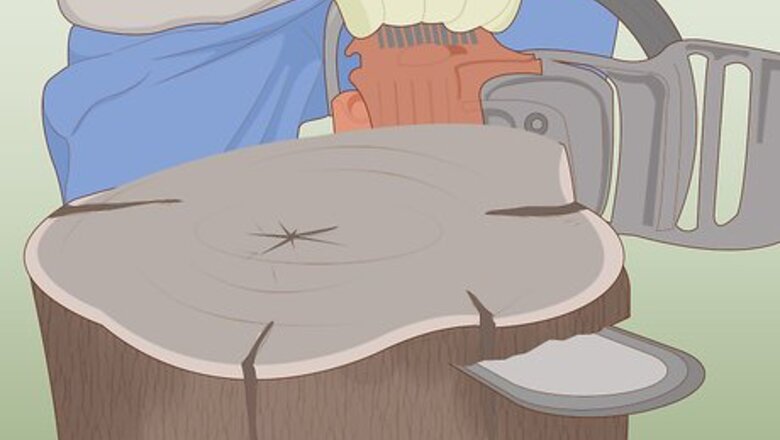
views
Making Your Stump into a Planter

Use a chainsaw to level the top of the stump. The top of your stump may not be flat and smooth, but it will need to be in order for you to make your planter. Turn a chainsaw on and then cut off the top 1–2 inches (2.5–5.1 cm) as evenly as possible. The chainsaw should cut through the wood quickly and easily. If you don’t already have a chainsaw and just want to use one for small projects like this one, choose an electric chainsaw over a gas chainsaw. The chainsaw that you use should have a guide bar that’s 2 inches (5.1 cm) longer than the diameter of the stump. Make sure that you wear safety glasses, gloves, safety pants, cut-resistant safety boots, head protection, and hearing protection when you use your chainsaw. You can expect your chainsaw to cost about $50-$200 USD.
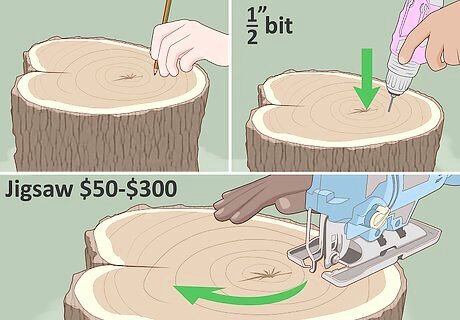
Cut the perimeter of the planter with a jigsaw. After you’ve created a relatively smooth, flat surface, use a pencil to draw a circle onto it as big as you’d like the planter to be. Use a drill and a ⁄2 inch (1.3 cm) drill bit to drill a hole along the drawn circle. Then, insert a jigsaw into the hole and follow the line as you saw. If you don’t already have a jigsaw, get one with an average motor power of around 5 amps or 18V and a maximum speed of about 3,000 SPM. Go with a jigsaw that has advanced orbital capabilities so that you can make smooth curved cuts. To avoid injury, wear eye protection and be mindful of where you place your fingers while you’re working. Make sure to take out the battery pack or unplug the cord before you change out blades or reposition the jigsaw. Jigsaws usually cost $50-$300 USD.
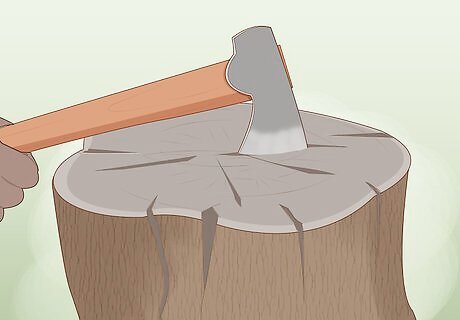
Hollow out the center with an axe. Use an axe to break up the wood located inside of the outline you made. Try to chip away at the center of the stump as much you can with the axe, while being careful to keep your aim inside the outline. Ideally, the planter should be about 6 inches (15 cm) deep. Keep this in mind while you use the axe on the stump. If you don’t already have an axe, consider getting either a small axe or a limbing axe for this project. These typically weigh 1.5-3 pounds (0.7-1.4 kg) and are 20–28 inches (51–71 cm) long. An axe should cost you about $20-$50 USD. To use your axe safely, get a good grip on it and only use it away from others when you have plenty of light to see what you’re doing. Also, stone-sharpen the blade regularly and keep the blade in a sheath when it isn’t being used.
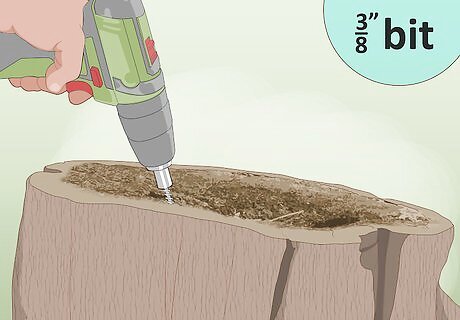
Weaken the wood with a drill. Once you’ve broken up and removed a lot of the wood, start using a drill to drill holes in different spots within the circle outline you created. Direct the drill up and down repeatedly until most of the wood within the circle is broken up into small pieces. Once you’re done, put down the drill and scoop out any loose wood inside of the stump. If you don’t already own a drill, go for a ⅜-inch (0.9 cm) cordless power drill for maximum mobility and versatility. Power drills typically cost about $50-$200 USD. Wear safety glasses, ear protection, and gloves while using your drill. Unplug the cord or remove the battery when you change out the bit and be careful with where you place your fingers while you work.
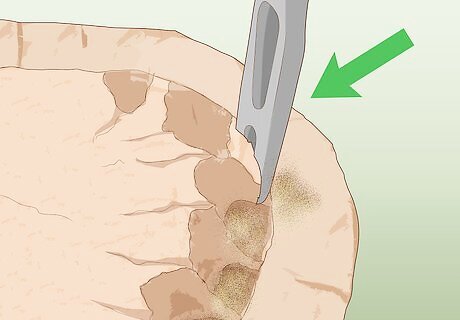
Use a hammer and chisel to chip away at the weakened wood. Look around the inside of the stump for wood that still needs to be removed. Hold your chisel in your non-dominant hand, and rest the end of the chisel on one of those areas. Then, chip it away from the rest of the stump by tapping a hammer, held in your dominant hand, onto the other end of the chisel. Continue doing this until you’ve chipped off all of the wood you want removed. For this project, you’ll need a nail hammer and a wood chisel. Hammers typically cost between $15-$50 USD and chisels are usually $10-$20 USD each. Wear safety glasses and focus on your aim while using a hammer and chisel to prevent injuries.
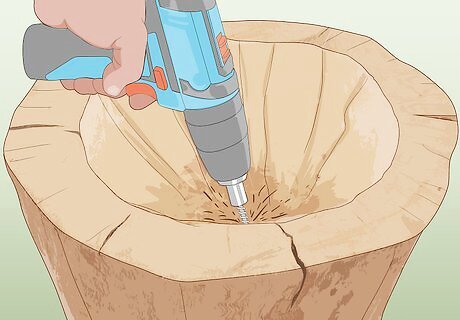
Drill drainage holes into the sides of the stump. To prevent root rot in your plants and flowers, you’ll need to drill some holes into the bottom of the planter. Hold your drill against the outside of the stump on the other side of the planter and drill all the way through to the bottom of the planter on the inside of the stump. Do this 2-3 more times, spaced evenly around the circumference of the stump.
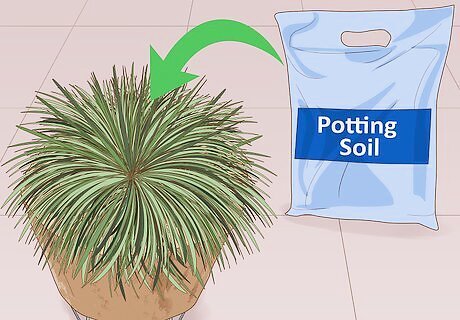
Fill the stump with soil and plant your flowers. Get a well-draining potting soil that’s rich in compost and fill your planter with it. Then, plant whatever plants you wish to have in your stump planter.
Building a Fairy House

Attach a door and windows to the outside of the stump. To make a basic fairy house, you’ll need a very small door and a few tiny windows. Purchase these online or paint them onto the stump as an easy option. As an artsy alternative option, make the doors and windows yourself out of popsicle sticks or other crafting supplies. Use a hot glue gun or a hammer and nails to attach the door and windows to the stump. If you want to make stained glass windows, hot glue pieces of sea glass to the stump on the inside of the window frame.
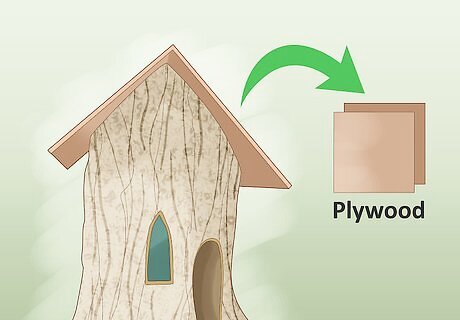
Set a roof on top of the stump. Measure how wide the top of the stump is to determine how wide the angle of the roof should be. Use hot glue or wood glue to attach the edges of 2 small, thin pieces of plywood together to make a simple roof. Place the roof over the surface of the stump. Consider painting the plywood a color of your choice after you glue it together. Let the paint dry completely before you set the roof over the stump’s surface. If you’re familiar with woodworking, you can also cut small rectangles of wood and attach them to the surface of the plywood to make shingles.
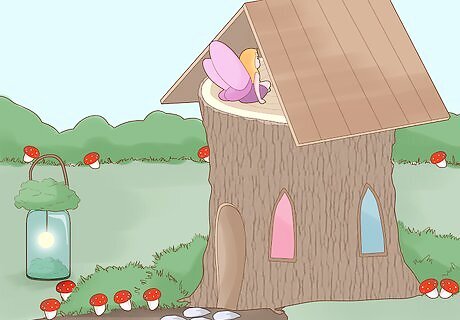
Decorate the outside with fairies and accessories. Collect small natural decorations for the outside of the fairy home, such as pebbles and twigs. Use these things to make cute additions to the outside of the home, such as a little walkway leading to the front door. Go online and purchase 1 or 2 fairies and several accessories, such as tiny wagons or benches, to set in front of the home. You can find fairies and fairy accessories on websites like fairyhomesandgardens.com.
Making a Mosaic on the Stump
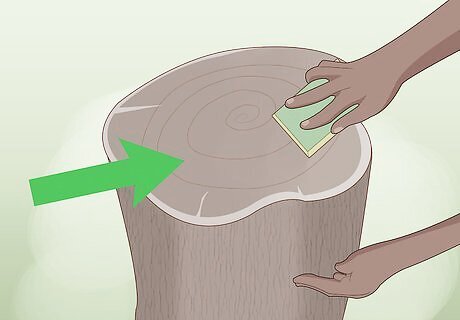
Sand and seal the surface of the stump. In order to make your mosaic, you must have a flat, smooth, waterproof surface to work on. Run a piece of sandpaper back and forth all over the surface of the stump to flatten any sharp edges. Then, coat the surface of the stump with a waterproof sealer to keep the stump from absorbing moisture and expanding and contracting as a result. You want to prevent this because it can cause your mosaic to crack.

Draft your design in pencil. Use a pencil to draw the image that you’re planning to create onto the surface of the stump. This can be anything from your initials to a picture of a sun and moon. Drafting the image beforehand may help to keep you from making a mistake as you make the mosaic.
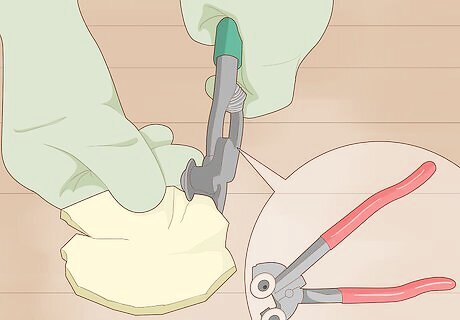
Crack your tiles into pieces. Hold a pair of wheeled tile nippers in your hand and pick up a tile. Place the tile between the 2 wheels with the grooved side facing up and then use both of your hands to squeeze the handle and break the tile. Continue doing this to all of the tiles that you plan to use in your mosaic. You can get mosaic tiles and wheeled tile nippers from your local arts and crafts supply store.

Squirt wood glue onto the stump surface and push down a tile piece. Squirt a small dab of wood glue onto the surface of the stump and spread it thin with a spoon if necessary. Then, quickly place a couple pieces of broken tile onto the glue with the grooved side facing down. Press down for several seconds. Repeat this process while creating your entire mosaic.

Use a spatula to apply grout to the surface of the mosaic. Once you’ve glued down all of your tiles, let the glue dry for 24 hours. Then, scoop some sand-less grout onto a flexible spatula and apply the grout to the entire surface of your mosaic. Wipe it smooth with the spatula so that the application is desirably even. Let the mosaic dry completely.
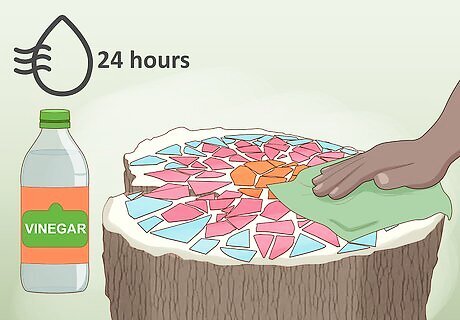
Clean off the tiles with white vinegar. After about 24 hours, the grout should be dry. At this point, you’ll need to clean the grout off of the tiles. Spray white vinegar onto your mosaic. Then, wipe the surface of the tiles clean with a cloth.




















Comments
0 comment